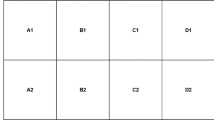Abstract
Bloodstains on textiles can provide useful information for the forensic reconstruction of a crime. Surprisingly, little is known about the applicability of bloodstain traces after a textile was machine washed. In this study, we investigated the effect of machine washing on bloodstains on both cotton and polyester cloths. The influence of the washing detergent, the type of washing machine, the washing temperature, and the duration of drying of the bloodstain prior to washing as well as the drying temperature was investigated. Additionally, the molecular analyses of a subsample of the experiments were conducted. We found that although the primary morphology of the traces is often blurred, the presence of blood on the textiles can still be detected in many cases. Blood can also be transmitted to previously blood-free textiles during the washing process, leading to a positive Luminol or Combur® reaction of these samples. When traces of blood can be detected via the Luminol reaction, a molecular identification of the blood donor was successful in 28% of the cases.











Similar content being viewed by others
Notes
Messler and colleagues (1981) showed that the height of dropping has an effect on the appearance of bloodstains on textiles.
It was tried to spray the samples with the same amount of spray since Zweidinger et al. [17] found a correlation between brightness on photos and the amount of Luminol sprayed onto the sample.
References
Peschel O, Kunz SN, Rothschild MA, Mützel E (2010) Blood stain pattern analysis. Forensic Sci Med Pathol 7:257–270. https://doi.org/10.1007/s12024-010-9198-1
Ramsthaler F, Peschel O, Rothschild M (eds) (2015) Forensische Blutspurenmusteranalyse. Lehmanns, Berlin
Robertson JR, Roux C, Wiggins K (2002) Forensic examination of Fibres, Second edn. CRC Press, Boca Raton
Brinkmann B, Madea B, Rand S (1985) Charakterisierung von Mikroblutspuren. Z Für Rechtsmed 94:237–244. https://doi.org/10.1007/BF00204088
Messler H, Berghaus G, Dotzauer G (1981) Der Einfluß textiltechnischer Größen eines Spurenträgers auf das Erscheinungsbild einer Blutspur. Kriminalistik Forensische Wiss 44:125–137
Messler H, Berghaus G, Dotzauer G (1982) Der Einfluss textiltechnischer Größen eines Spurenträgers auf die Aufnahmefähigkeit für Blut. Arch Kriminol 169:99–113
Rand S, Madea B, Brinkmann B (1985) Zur Morphologie von Blutspuren. Beitr Zur Gerichtl Med 43:259–264
Quickenden TI, Ennis CP, Creamer JI (2004) The forensic use of Luminol chemiluminescence to detect traces of blood inside motor vehicles. Lumin J Biol Chem Lumin 19:271–277. https://doi.org/10.1002/bio.780
Gifford WD (1999) Bloodstain survival in water. IABPA News 15:1–6
Adair T, Shaw R (2005) Enhancement of bloodstains on washed clothing using Luminol and LCV reagents. IABPA News 21:4–10
Kunz DSN, Adamec J, Gilg T, Kaiser C, Peschel O, Schulz MM (2012) Visualisierung latenter Blutspuren. Rechtsmedizin 22:61–72. https://doi.org/10.1007/s00194-011-0794-5
Kamphausen T, Fandel SB, Gutmann JS, Bajanowski T, Poetsch M (2015) Everything clean? Transfer of DNA traces between textiles in the washtub. Int J Legal Med 129(4):709–714
Noël S, Lagacé K, Rogic A, Granger D, Bourgoin S, Jolicoeur C, Séguin D (2016) DNA transfer during laundering may yield complete genetic profiles. Forensic Sci Int Genet 23:240–247
Voskoboinik L, Amiel M, Reshef A, Gafny R, Barash M (2017) Laundry in a washing machine as a mediator of secondary and tertiary DNA transfer. Int J Legal Med:1–6
Weber K (1966) Die Anwendung der Chemiluminescenz des Luminols in der gerichtlichen Medizin und Toxikologie. Dtsch Z Für Gesamte Gerichtl Med 57:410–423
Quickenden TI, Creamer JI (2001) A study of common interferences with the forensic Luminol test for blood. Lumin J Biol Chem Lumin 16:295–298. https://doi.org/10.1002/bio.657
Zweidinger RA, Lytle LT, Pitt CG (1973) Photography of bloodstains visualized by Luminol. J Forensic Sci 18:296–302
Schulz MM, Brune V, Maierthaler M, Graw M (2011) Visualization of latent biological traces via 5-methylthioninhydrin (5-MTN) staining for forensic DNA typing. Forensic Sci Int Genet suppl series 3:530–531
Nilsson A (2006) The forensic Luminol test for blood: unwanted interference and the effect on subsequent analysis. Linköping University: faculty of health science
Acknowledgments
This work was supported by the Lehre@LMU-Award for student research projects of the Ludwig-Maximilians-University Munich. We thank C. Helmreich und F. Kraus for multiple blood sampling and the male and female volunteer for their blood donation.
Author information
Authors and Affiliations
Corresponding author
Ethics declarations
Conflict of interest
The authors declare that they have no conflict of interest.
All procedures performed in studies involving human participants were in accordance with the ethical standards of the institutional and/or national research committee and with the 1964 Helsinki declaration and its later amendments or comparable ethical standards.
Electronic supplementary material
ESM 1
(DOCX 78 kb)
Rights and permissions
About this article
Cite this article
Hofmann, M., Adamec, J., Anslinger, K. et al. Detectability of bloodstains after machine washing. Int J Legal Med 133, 3–16 (2019). https://doi.org/10.1007/s00414-018-1897-2
Received:
Accepted:
Published:
Issue Date:
DOI: https://doi.org/10.1007/s00414-018-1897-2




